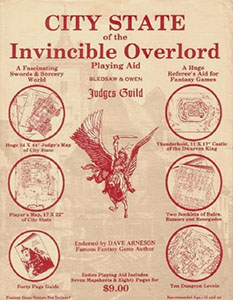 In our quest to understand urbancrawls, let’s turn our attention now to the Judges Guild. Despite a recent resurgence, I think that most people still vastly underestimate the seismic influence they had on the early development of the hobby: They were experimental. They were groundbreaking. They were cutting edge. And a lot of the stuff that was revolutionary when they did it had become “business as usual” in the hobby just a few years later. A lot of it remains business as usual even today.
In our quest to understand urbancrawls, let’s turn our attention now to the Judges Guild. Despite a recent resurgence, I think that most people still vastly underestimate the seismic influence they had on the early development of the hobby: They were experimental. They were groundbreaking. They were cutting edge. And a lot of the stuff that was revolutionary when they did it had become “business as usual” in the hobby just a few years later. A lot of it remains business as usual even today.
(This was most recently impressed upon me afresh when I realized that the hexcrawling procedures in AD&D were based almost entirely on the material developed by Judges Guild: The structures from OD&D were essentially abandoned completely.)
CITY STATE OF THE INVINCIBLE OVERLORD
City State of the Invincible Overlord is not only the first city supplement ever published, it’s also one of the first adventure modules to be published (being predated only by Palace of the Vampire Queen and the original version of The Lost Caverns of Tsojconth).
The first thing I note as I page through the book is that Bob Bledsaw and Bill Owens have a very clear concept of how this material will actually be used at the table. There’s a definite, utilitarian structure to everything they present. Unfortunately, what their practices actually were – what specific procedures they would have used when running the City-State – are unclear almost to the point of being an enigma.
The key for City State of the Invincible Overlord is organized by street. For example, the description of the city begins with a list of all the notable locations on Barter Street:
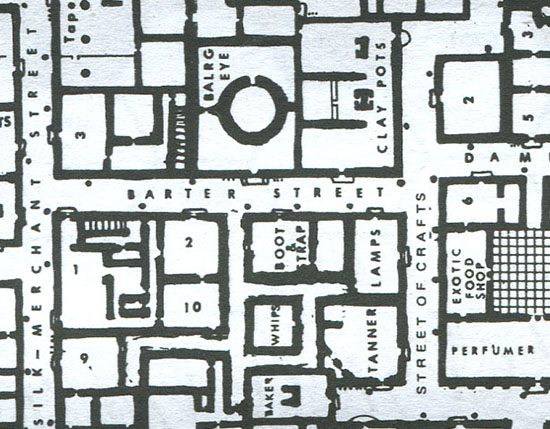
Each location entry generally consists of notable NPCs and a brief description. These are not terrible different from what you’d find in a city gazetteer today and not particularly helpful from a structural or procedural standpoint.
There are, however, two points of interest to be found here: First, each street has an encounter keyed to it. For example, Barter Street:
PROB 38% of being surrounded by Street Urchins demanding 1 CP each to go away
According to the standard procedures hidden away on page 5, these encounters are “rolled on alternate turns (on the turn that a normal encounter is not rolled)”. In order to check for the encounter, you roll 1d6. If you roll a 1, you then roll the percentile check of the keyed encounter.
What constitutes a normal encounter is, as far as I can tell, not explained. (We’ll have to turn to the Ready Ref Sheets for that, which we’ll do in a moment.) Also unexplained is what constitutes a turn. In OD&D there were both underworld turns (10 minutes), wilderness turns (1 day), and combat turns (1 minute). (Although, to be fair, OD&D itself is pretty vague about which type of turn is used in many situations.)
For our purposes, this sort of detail isn’t particularly relevant. What would be nice to know, however, is exactly how Bledsaw and Owens handled movement at the table: Were the players, in fact, navigating street-by-street? The fact that specific turn-by-turn time was being kept and encounters being generated based on exactly which street they were on during a particular turn rather strongly suggests that they were. (And this is reinforced by guidelines like, “There is a 20% PROB of blockage by Wagons, Horses, and Goods. A 10% PROB exists of an object being dropped from above per turn. Distances 10-60 feet.”)
The second point of interest is that each keyed location includes a Rumor or Legend, such as:
Legend, the Cauldron-Born: A Lich in the Dearthwood is creating an army of Synthetic Giants.
Or:
Rumor: A Djinn is coming south on Constable’s Street.
These are obviously very similar to the rumors we see later in Keep on the Borderlands and The Village of Hommlet. Taken in its totality, however, I think we discover that City State of the Invincible Overlord provides a much richer and more robust urban environment: The players are expected to truly explore the city in order to retrieve the rumors which will propel them towards adventure. And in the process of that exploration, the city will impose itself upon them in the form of encounters.
This basic structure is then supplemented with a variety of ancillary material: Town criers and vigilantes; a sub-system for being questioned by city guards; an entire method for placing advertisements and determining the response; and so forth. Add in little sub-systems for intoxicants, gambling, and the like and it’s not hard to see that the city was a mish-mash of color, information gathering, and carousing.
MODRON
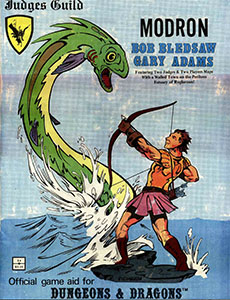 Fast forward a year and we have Modron: Not to be confused with the polyhedral monsters which would later use the same name, this is actually an often-overlooked city supplement written by Bob Bledsaw and Gary Adams.
Fast forward a year and we have Modron: Not to be confused with the polyhedral monsters which would later use the same name, this is actually an often-overlooked city supplement written by Bob Bledsaw and Gary Adams.
It’s notable because it marks an evolution in Bledsaw’s approach to urban supplements: Although encounters are still keyed by street, the gazetteer of locations is now organized by area (Stadium Area, Open Market, The Docks). Rumors and Legends are gone, however, leaving the city as a utilitarian husk colored with the occasional random encounter.
READY REF SHEETS (1978)
In 1978, the second edition of the Ready Ref Sheets finally reveal to us how a “normal encounter” is determined in the city. In practice, it turns out to be an incredibly rich method for procedurally generating urban content.
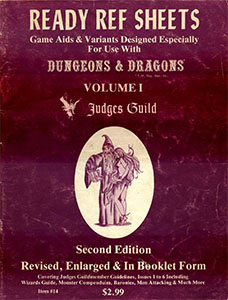 First, check for an encounter. Encounters have a 1/6 chance every other turn. (Thus matching the same rate as dungeon and wilderness encounters, although once again the length of this “urban turn” is left undefined.)
First, check for an encounter. Encounters have a 1/6 chance every other turn. (Thus matching the same rate as dungeon and wilderness encounters, although once again the length of this “urban turn” is left undefined.)
Second, determine the type of encounter: Attacked by Surprise, Attacked, Slanders/Insults, Questions Player(s), Propositions Player(s), or Special Encounter.
This second step is what really makes the whole system work: Basically everything else in the process simply determines who you’re encountering, but this initial step colors the encounter. (Combine it with the “Attack Reasons” table from pg. 74 of City State of the Invincible Overlord and you’re really cooking with gas.)
This is all the Ready Ref Sheets have to offer us, but I think it’s important: Understanding where the procedural content generators are and how they work in a ‘crawl is vital to keep the ‘crawl vibrant and alive over the course of a campaign.
CITY-STATE OF THE WORLD EMPEROR
City-State of the World Emperor is a really weird product.
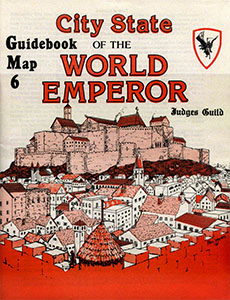 First, it has an entire volume dedicated to 80 pages of generic, unnamed shops. And none of these shops are actually keyed to the map: The GM is supposed to place them wherever they find convenient.
First, it has an entire volume dedicated to 80 pages of generic, unnamed shops. And none of these shops are actually keyed to the map: The GM is supposed to place them wherever they find convenient.
The other significant volume of the set is just a giant mish-mash of completely unorganized information. It includes both a table of “Rumors” and a table of “Random Rumors” (although what the distinction is supposed to be between these categories is left completely unexplained).
Gone are the street-based encounters and the rumors keyed to specific locations. In their place, however, Volume II: Shops has a robust “cache” system: Each location indicates how many caches of loot it possesses, and you can use the cache system to determine where it’s hidden; how it’s hidden; and how much is hidden. This is coupled with the following rejoinder:
As a general state of affairs people in the City State of the World Emperor tend to be a level or two higher than those in the City State of the Invincible Overlord owing to the tougher level of competition. Also since more trade flows through Viridistan the level of cash flow and total of treasure are slightly greater. Beware; since the guards and traps are tougher too!
The impression one is left with is very much of a “hack ‘n slash” urban environment and the expectation seems to be that the PCs will be kicking doors down and looting the premises.
Also of note, however, is that Volume III: Guidebook to the City includes an explicit “Play Guide”. This leads off by saying, “It is important that played characters interact with NPCs.” It then includes a robust system for handling rumors, tracking how long abstract interactions with NPCs take, mechanics for “establishing camaraderie”, and play tips for successfully gathering information (“talk with everybody… encourage the relating of rumors… learn about sudden unusual behavior… concentrate on getting to know persons of one’s own rank, position and interests”). So the collection of information is still clearly placed in center of the urban spotlight and it’s particularly interesting to see the mechanistic way in which these interactions are handled. For example:
One rumor (maximum) can be heard per every two hours in an eatery (food or drink). One rumor per hour can be heard in an inn (food, drink, and beds). Three rumors per hour can be heard in a tavern (drink). One hour of conversation equals four turns of interaction if with different people, or six turns of interaction if with one person. Ten interactions equal one turn. One interaction equals two verbal statements (or questions) and two retorts (minimum). About 50% of rumors are true.
FINAL THOUGHTS ON THE JUDGES GUILD
Here, however, our time with Judges Guild draws to a close. In 1983 they would produce a final city-state product – City State of Tarantis – but this product moved entirely to a modern gazetteer style: These are the books that read like a Baedeker’s guidebook. They provide the backdrop for adventure 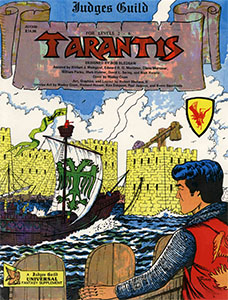 without really giving us anything in the way of structural clues.
without really giving us anything in the way of structural clues.
In reviewing what we’ve learned from the Guild, I’ll start by saying that I’m probably not interested in using strict turn-by-turn timekeeping while exploring a city. The kind of street-by-street navigation that seems to be getting advocated here might be interesting for a short while during an “explore the new city” phase, but I don’t think that it would represent effective pacing in the long run. (Featuring, as it almost certainly would, a lot of decisions that nobody at the table really cares about.)
The idea of keying content to specific streets, however, is an interesting one. Consider the possibility of combining this with target-based movement: When the PCs are leaving or arriving at a location, could we check for encounters keyed to those streets in order to provide color to the urban environment as they move through it on their errands?












Looking at this, it’s easy to see why people still call back to the City State of the Invincible Overlord.
I’m not sure if there’s a better way to organize the crawl than streets, but they have the basic pieces I’d want in place: procedural content generation and hooks thick on the ground.
Watching them move away from that as the post progresses is a little sad. Like “Hi, new friend! Oh, okay, bye new friend…”
Cheers!
Kinak
This post is bad ass.
A lot of OSR stuff is really phoning it in lately but this post brings the pain. City crawls are a missing tool for RPGs today and this is some genuine detective work about a genuine old school way of handling it. Nice work!
Any familiarity with the ~2004 d20 reprinted/expanded version of CSOTIO from Necromancer? I was poking about city books that could be adapted for a potential 5e game and was reminded of this classic, but was wondering what version might be worth looking into.
I’m still playing off the idea of a urbancrawl-style game from the other side of players as constables/town guard doing almost a fantasy version of a police procedural, with use of all this sort of rumors as different “beats” and “cases”…
The Necromancer Games version is almost certainly the way to go: It’s an incredibly faithful presentation of the original, with improved organization and better maps. It also includes an updated version of the original Wraith Overlord (presenting a number of dungeon locations underneath the city).
I know that the recently revived Judges Guild just completed a Kickstarter for a new version of the city adapted to Pathfinder. But I don’t think any material has come out of that yet.
(Researching that, however, made me aware of the brand new City-State of the Sea King that they produced last year. I’m intrigued, but not quite $40 intrigued.)
Just caught up on this whole series. Excellent stuff. I’m hoping the next post on other old school cities goes to Sanctuary from Thieves’ World and Pavis and Big Rubble for RuneQuest… My tips for old school cities!
The JG just gave out copies of the original and a 1990s revision (mostly better typesetting) to those who backed its Kickstarter for Rob Conley drawing new maps, and I get to see just how dense these really are. I can’t imagine trying to use this at the gaming table and finding anything fast. I count 33 establishments, each with at least one fully-statted NPC, in the first four-and-a-half pages of listings.
“The kind of street-by-street navigation that seems to be getting advocated here might be interesting for a short while during an “explore the new city” phase, but I don’t think that it would represent effective pacing in the long run.”
It was effective pacing even after the first run through or two… Judges Guild never designed their city-states to be a place where the players would be safe, and could just go shopping at the magic and weapons mall with their murderhobo earnings with all their freinds. Unsaid in every encounter …however implied, is that behind every low level encounter on the street is some nobleman, or faction…
Have a scrap with the local city guard or militia of the Imperial Overlord did we? Killed a few of his guards and escaped with your loot did you? From Booklet I – CONSTABLES of the City-State are characterized by their bumbling ineptitude… If you are killing those sad low level citizens, …in short order you are going to get the attention of the Black Lotus, and the Overlord’s secret police will begin hunting you… just for the Lolz…
Let me just quote a little bit of background from page I-16 here for you…
The Overlord can overrule any act of the Senate depending on his whims at the moment (1 in 12 chance per day). The senate consists of 30-36 Lords, 12-16 Patriarchs and Evil High Priests, 0-5 Wizards, 1-5 Druids, 1-4 Master Bards, 1 Master of Monks, 1 Ranger Lord, and 1 Paladin Lord. Each alignment group sets in a quadrant of the Stadium. Senators get 1 vote for every 200 troops under their command, and other Senators receive one vote for every three levels they have advanced. Each Senator supplies the Overlord with palace guards: The temples each supply one Bishop, and the Wizards each supply a magic user (of 2-8 level), the Lords each supply 1-6 fighting men (of 3-8 lvl) etc.
So, in CSIO there is a minimum of fifty Senators, all named level Lords of Superhero capability (at the very minimum, eighth level) that run the council, each has the equivalent of a Castle full of followers and guards in whatever part of the City-State they live in.
The Intro goes on to describe the overlords personal bodyguard which include, among other creatures, A Balrog, a Mind Flayer, a Beholder, a pack of hell hounds among other critters… and then it goes on to describe what happened to the Lawful Good resistance in town… Then there is this interesting little tidbit…
In addition, The Overlord’s secret police (called the Black Lotus) pervades all social levels to the extent that any organized rebellion will come to his attention (1 in 6 chance per day) no matter how secret.
there are some descriptions of various areas… here are a few for you…
The Waterfront quarter is a dank and damp locale to live in. Check for Tuberculosis (2% Prob) once per game week for any character stationed or roaming there.
The Mermist swamp is swarming with Mosquitoes, check for yellow fever in the spring and summer (Prob 4% per 2 days) Likewise Dearthwood has Giant Ticks and 80% transmit spotted fever if they manage to bite.
No my friends… Getting into and then out again of the CSIO is like a Dungeon Crawl in the sunshine, only the density level of potential hostiles is far higher than the players will ever find in a dungeon. It is rumored that even the Gods themselves walk the streets of the City-State. I’d enjoy seeing players try to murderhobo a God in disguise, or the followers of a God in disguise, while the Deity is watching.
We always cherished getting in without paying too much, or losing any party members, made the best deals we could to sell our loot, paid our taxes and bribes discreetly, and with some luck found a bolt-hole somewhere in the City where everyone could rest up and heal so we could return to the much safer wilderness to explore for forgotten dungeons, or some lost treasure, or mines…
Any name level priest in the City can cast a Quest on the party, compelling them to go on an adventure not of their choosing, Just about every Wizard except for the 10th level MU can cast Geas, also compelling adventurers (The Players) to risk their lives and recover whatever the Wizard desires… so there was always that.
No, we viewed going into the City-State as something we wouldn’t willingly do, because of all the hazards there, it was, from time-to-time, a place we had to go, to sell our valuable treasures and get a fair price, or to spend some gold, to get some high quality weapons and magic that we wouldn’t want to waste on some low level city guard. Just satyin’ Going into the City-State was an adventure every time. That is the way i ran it as a GM, as well.
I found these posts very helpful having struggled with one of the few supplements that takes place in an actual city.
I imagine, like The keep on the borderland, the players would find retainers, train or find trainers, unload loot etc but over this is layered an adventure via the route chosen by the players. What encounter will they have on the way to the sage that will identify their recently acquired items? Will they take market street or will they try longer but safer route? Great stuff.
I feel it’s what Bethesda’s Daggerfall was trying to accomplish when you’d chat to a bookseller and The proc gen quest would trigger and he’d accuse you of stealing a gem from him Forcing you to hunt around the city asking passerbys where Someone named thoroad thickwood Was before giving up and getting arrested.
I know the gygax ad&d version does it. Maybe the necromancer games does it as well, but the decision to key the map to ‘districts’ seems wrong. Not least because the random encounters are keyed to ‘streets’, so even if the PCs say they’re going to X district the dm still needs to ask what street.
Secondly, it removes the street by street navigation and condenses the city so as to make it feel smaller by dividing it into larger pieces instead of a myriad of streets which I would think would aid in mental navigation and verisimilitude.
The street-by-street exploration does intrigue me, even if I agree it would make for bad pacing… in a normal city. However I can absolutely see it working in a location of dense activity or danger, such as a mardi gras style festival day where the streets are packed and there are constant interruptions. Similar might be Night City’s Combat Zone, a region of lawlessness within the city where you could be jumped on any corner.
For these examples, this “street-crawl” exploration functions as the city analogue for a finding a dungeon whilst wilderness exploring, but without requiring that rigid enclosed environment. Each street is more similar to a room, corridor, or series of relates rooms, that you crawl along and perform encounters. You can duck into alleyways and buildings as well with possible encounters for shops and residences. Having a vehicle would let you get by faster and perhaps reduce most passerby encounters. Once you exit the region of activity, you re-enter city crawling.
In this way, you could introduce these locations around the city according to events and political changes, providing the city with dynamic crawls that dont dominate every hex. The festival might just take over the hex for a week, then return to normal.
Apologies for thread necromancy, but one useful video game series that radically innovates on the street-crawl structure, which could probably be used as inspiration for fleshing out the street-crawl further, is Pathologic (a Russian horror game series about fighting a plague: Pathologic 2 is a re-imagining of the original).
The game’s main macro-structure is to complete quests while maintaining survival meters (hunger, health, exhaustion, etc.), but it manages to make the process of getting from point to point extremely stressful by using a slow street-crawl that forces players to make broader navigational decisions (“do I enter this infected district to save time, or do I just path around it and potentially lose time in the process”) and split-second decisions based on random encounters in the area. In most districts, you might come across burglars or arsonists who will attack you, or passersby who might have cool things to trade, or trash cans to get useful things to trade, just by walking around. In infected districts, you might also get attacked by plague clouds or rats, and being infected isn’t an insta-kill but rather makes the rest of the game much harder.
It’s essentially a solid (video game) execution of @qyubey’s street-by-street exploration proposal, and I’d recommend checking it out (or at least SulMatul’s/HBomberguy’s videos on it) since it really manages to integrate the slow pace of street-crawling into the broader quest/survival structure as well into the micro-level structures of bartering, visiting stores, gathering, combat, etc.
one striking thing about rumor delving to get adventure hooks is exactly the way i use ‘civilization’ in my DnD games. there is a push and pull between dungeon exploration and civilization. clues in the dungeon pull one out to the civil world and rumors from the civil places push one back to dungeons in a continuous tidal like tug of opportunity so the dungeon/underworld can refresh as well as the civil/outerworld.